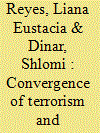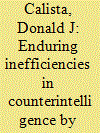|
|
|
Sort Order |
|
|
|
Items / Page
|
|
|
|
|
|
|
| Srl | Item |
| 1 |
ID:
138896


|
|
|
|
|
| Summary/Abstract |
This article examines the convergence among ethnic groups, narco-traffickers, insurgents, and terror organizations in Central Asia. It analyzes the lucrative business of drug trafficking and the diffusion of globalization, which have undoubtedly brought these once disparate groups together. It will explore how the increasing movement of illicit goods and people, proliferation of transportation technology, growing infrastructure, cooperative ethnicities, as well as a shared need for funding, have provided these groups with an opportunity to consolidate their efforts in ways that were not possible in the past.
|
|
|
|
|
|
|
|
|
|
|
|
|
|
|
|
| 2 |
ID:
130231


|
|
|
|
|
| Publication |
2014.
|
| Summary/Abstract |
A lot of time we are chasing shadows, but it's better to do that than find out later you let something get by. (An FBI field agent-Type I Error or a false positive). 1
The best chance for success [terrorists] have is to get somebody who is not a visitor [to] come in as a permanent resident or citizen, who knows the culture and how to move around, who doesn't have a record, so as not to get picked up by a database. (A former senior U.S. intelligence official-Type II Error or a false negative). 2
These two citations reflect divergent responses to the governance structures of terror organizations that continue to be subjects of interest and debate among scholars and practitioners. The operational character of terrorism remains essential to the development of strategic initiatives by counterintelligence (CI) agencies. To position CI more advantageously certain concepts from New Institutional Economics (NIE) might be utilized. 3 NIE's central formulation of principals and agents assumes that people make rational choices in determining whether to plan their transactions (relationship costs) into one of two kinds of configurations: market (decentralized) versus non-market (centralized) endeavors. Effectively, the challenge is to determine which transactional method offers greater prospects to achieve efficiency. Inherent limitations (externalities) of time, place and resources complicate these choices. Those involved can be divided into owners (principals) and workers or suppliers (agents). In fulfilling any agreed upon duties, transaction costs then center on the degree to which principals undertake monitoring the behavior of agents for possible shirking-referenced by NIE as the "agency problem."
|
|
|
|
|
|
|
|
|
|
|
|
|
|
|
|
| 3 |
ID:
175740


|
|
|
|
|
| Summary/Abstract |
The study addresses the question of whether there is a global pattern of terror organization (TO) lifespan. Based on two datasets which include hundreds of organizations, we show that there is a global statistical law of TO lifespan distribution. This distribution describes populations of TOs in different contexts of periods, geographical locations, ideologies, etc. The data as a whole, as well as its subpopulations, seem to emerge from an exponential distribution, which is formulated as a mathematical model. This model enables the prediction of TOs’ global population decay rate. The findings were obtained by introducing a novel procedure, which formulates and validates this mathematical law for discrete empirical data. We suggest that human behavior generating informational cascades and a positive feedback loop, which influence the number of core members in a TO, may be the source of this global pattern.
|
|
|
|
|
|
|
|
|
|
|
|
|
|
|
|
| 4 |
ID:
188373


|
|
|
|
|
| Summary/Abstract |
This study examines the relationships between poverty, economic inequality and joining to terror organizations. Based on the rational-economic model, differently, from previous studies, we focused on the organizational level. We hypothesized that in a poorer base country of operation and in a base country of operation in which the economic inequality is wider the likelihood of terror organizations to become larger (higher number of core activists) is higher. Using GDP per-capita and GINI index as proxies and several statistical methods we tested these hypotheses analyzing hundreds of terror organizations. The findings are that there are no robust relationships between poverty and economic inequality and the number of people who joined them. However, the likelihood of a larger terror organization – lifetime, defeat as the life-ending cause of the organization and political goal – regime change, found to be significantly related to the size of terror organizations.
|
|
|
|
|
|
|
|
|
|
|
|
|
|
|
|
| 5 |
ID:
147594


|
|
|
|
|
| Summary/Abstract |
In the last few decades, terrorism has become a global threat and challenge, which many countries have had to face and fight. Conflicts involving terror organizations are, to a large extent, battles of ideas, and are not focused only on physical violence or military confrontation. This reality creates a need to better understand the tools through which terror organizations promote their messages, and to distinguish between different types of terror organizations. The current study examines different types of terror organizations' messages targeting foreign audiences. The analysis focuses on the organizations' usage of public diplomacy in promoting their messages and distinguishes between the different types of organizations (limited- versus total-conflict). Messages promoted by four terror organizations—Hamas and Hezbollah (limited-conflict organizations) and Al Qaeda and the Islamic State (total-conflict organizations)—are analyzed. The findings reveal that while limited-conflict organizations communicate with the international community, and use public diplomacy to try to change the international environment in which they operate, total-conflict organizations do not use public diplomacy; they talk about the international community rather than communicating with it.
|
|
|
|
|
|
|
|
|
|
|
|
|
|
|
|
|
|
|
|
|